by aschortinghouse | Jul 27, 2018
GAGA BALL
If your youth has attended 4-H Camp Timpoochee or Cherry Lake with the UF/IFAS 4-H Camping Program, they’ve had the chance to play GaGa Ball. You’re probably wondering what kind of name is GaGa ball. It’s not just a made-up name. GaGa ball has a rich history. GaGa is translated from Hebrew as “touch-touch”. It’s said to have originated in Israel, and it has become a popular game at camps around the United States. GaGa Ball is a version of dodgeball and is just as fun.
LET’S PLAY!
GaGa ball is not only fun to say, but it is really easy to learn. First, you need a place to play. GaGa ball is played in a GaGa pit. Here’s just one of many articles on how to build your own GaGa Ball Pit. Next, you need a ball. GaGa balls are not specific, although a heavy duty dodgeball is recommended. The rules of the game vary place to place, but we play by the following rules at 4-H Camp:
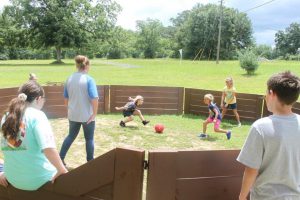
- You hit the ball with your hands only.
- If the ball hits you below the knee, you are out.
- If the ball bounces of the wall and hits you below the knee, you’re out.
- If you hit the ball out of the pit, you’re out.
- If you hit someone in the face, you’re out
- If the game is going slowly, the leader can call “Hands-In”.
Hands in means everyone who is already out can put their hands over the wall of the pit and try to get those still in the pit out.
Rules can be made and altered to fit the group that is playing the game although the first two rules are staples of the game.
WHAT’S THE BIG DEAL?
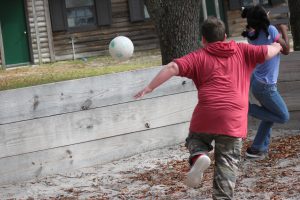
GaGa ball is a great way to expend extra energy during day camps, but it also is a great way to build and practice life skills. First off, youth are put in situations in every game where they have to practice decision making, discipline, resiliency and many other life skills 4-H strives to instill in our youth. Of course they have to practice their conflict resolution skills as there will inevitably conflicts that arise from their competitive natures. Most importantly, playing GaGa ball helps kids practice a healthy lifestyle. GaGa ball teaches many important lessons, and is a bunch of fun. So when you hear someone say, “Let’s play GaGa ball!”, give it a try and embrace the challenge.
Learn more about the history of GaGa Ball
by pmdavis | Jun 29, 2018
Summer time is a great time to teach youth about solar energy!
Use s’mores to teach your kids about two different types of energy: kinetic and radiation. Kinetic energy is energy in motion. Radiation is energy made through electromagnetic waves. Heat and light waves penetrate food without direct contact between the heat source and the food. Solar ovens, toaster ovens and microwaves are all methods of radiation cooking.
To make the solar oven like you see below, get a pizza box and follow these steps:
- Line the inside of the box with foil.
- Make an opening on the top of the box by cutting three sides leaving the other side attached so it flaps open.
- Cover the opening with clear plastic wrap.
- Assemble your s’more (see tips below).
- Close the lid of the box and raise the foil covered flap.
- Make sure the sun is reflecting onto the oven opening.

Remember to orient your box according the time and sun location. For example, if it’s late afternoon and the sun is on your right, you must be facing south. You would want to turn your oven so the reflective waves would be heating up your oven in more of a westerly direction.
Hints and Tips
- Place the graham cracker and marshmallow in the oven first.
- Add the chocolate once the marshmallow is partially cooked. (Otherwise, the chocolate will be liquid by the time the marshmallow is melted).
- Speed up the process by preheating your oven.
- Give yourself time and other activities to keep the group entertained. It took the group pictured above about an hour to have the tasty treat!
Want more science tips and ideas?
Check out these sites to discover more fun science: http://edis.ifas.ufl.edu/ , http://florida4h.org or http://utah4h.org/discover/.
For more information about how 4-H incorporates science into learning, contact your local extension office.
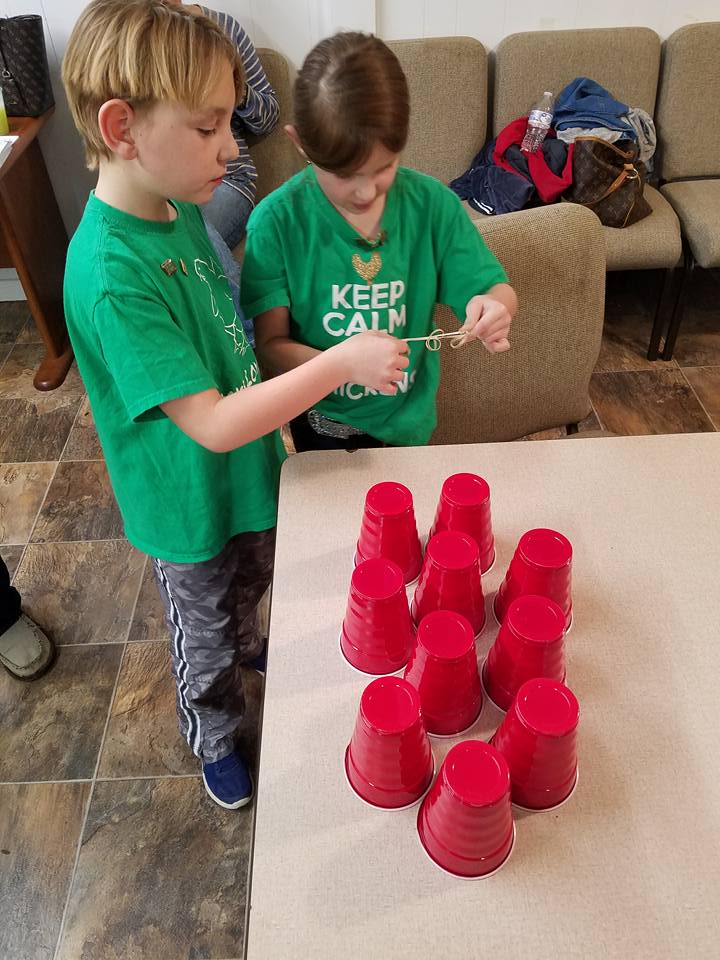
by Rachel Pienta | Jun 15, 2018
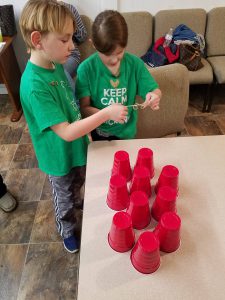
4-H members play the stacking game at a club meeting.
Summer is here, and I’m picturing long and lazy sunny days at the lake or beach. In Florida, the warm, sunny days of summer also bring afternoon thunderstorms and the possibility of tropical storms and occasional hurricanes.
What to do on rainy summer days?
During the summer months, the days of sunshine may be interrupted with periods of rainy weather. For children, rainy weather often means long hours spent inside the house. While some children welcome rainy days to spend time curled up with a book, reading for hours at a time will not occupy every child.
For parents looking for indoor activity options for children beyond movie marathons and video games, using household items already on hand can provide fun alternatives to endless screen time.
STEM CHALLENGE AT HOME
A fun activity that only requires string, rubber bands, and sturdy plastic cups will challenge your children to work together and think creatively to problem solve. The “Stack ‘Em Up: Introduction to Engineering Activity” challenges children to think like engineers. The activity is best done with 4 to 6 children. This is a great activity for children to enjoy when the neighborhood group converges on your house for a rainy afternoon! A complete instruction guide for this activity is included in the links below this article.
HOME KITCHEN CHALLENGE
A number of popular television cooking shows involve challenge competitions with special or limited ingredients. Parents can adapt this concept to help their children develop basic cooking skills while also giving them an opportunity to be creative and problem solve. This “do it yourself” at home cooking competition, adapted from PBS Kids, offers an easy fun way to engage children in creative kitchen fun:
• Divide the kids (or kids and adults) into 2 or 3 teams of 1 – 2 people.
• Gather a set of cooking items for each team – utensils, measuring instruments, bowls, etc.
• Choose an adult or older child to be the judge and/or the announcer/assistant. The judge can also decide on the “Secret Ingredient” that will be revealed to the contestants. Consider making it a fruit, a raw vegetable like carrot, cucumber, or celery, a grain item such as bread or cracker, or a spice like ginger or cinnamon.
• Set up individual or team “cooking stations”. Your cooking competition may be preparation only – without a stove, microwave, or oven.
Plan in time for taking turns cooking if your items will need to be heated or if appliances such as blenders or stand mixers will be used.
To add an additional layer of challenge, parents can decide to limit each time to one preparation method for individual teams or across all teams.
• Decide ahead of time how many additional ingredients competitors may “shop” for in the kitchen.
• Designate a separate spot for the judge or multiple judges to taste the food. This station should be equipped with a plate and eating utensils, and a palate cleanser like water or crackers. For more fun possibilities, create scoring cards with categories for taste, originality, good humor or sportsmanship, and presentation.
• Use a timing device like a kitchen or cell phone timer to add in the time element to the challenge. The suggested competition time is 20 minutes. The 20-minute time should include the child’s recipe planning time. Decisions will need to be made quickly!
• When time’s up, have each team present their creation to the judge, including a verbal description of flavors and the preparation technique. The judge(s) can taste each one and fill out the scorecards.
• Need ideas for prizes? Consider awarding a new cooking utensil like a colorful spatula with a certificate or card declaring the winner(s) “Master(s) of the Grand Spatula!”
• Want to involve additional older children or adults? Designate reporters to videotape and interview the contestants. Extend the fun by watching all the videos once the competition ends or before the winners are announced.
WHEN IT RAINS, GROW CREATIVE FUN FAMILY TIME AT HOME
The next time the summer forecast calls for rain, be prepared with these “rainy day” activity ideas. For more ideas, please contact your local UF/IFAS Extension Office.
How to Create a Cooking Challenge for Kids
How to Host a Cooking Competition for Your Kids
Stack ‘Em Up Activity
http://ngcproject.org/sites/default/files/9.6_stack_em_up_activity.pdf
https://www-tc.pbskids.org/fetch/games/activities/pdf/FETCH_StackEmUp.pdf
by amgranger | Apr 20, 2018
Expanding Horizons and Teaching Work Ethics

Jackson 4-H Volunteer Terri Hardin.
Jackson County 4-H volunteer club leader Terri Hardin wears many hats. From working with youth at Golson Elementary School to working on her family ranch in Grand Ridge, Terri is one busy lady! Somehow though she manages to find time to meet with the youth in the Country Bumpkins 4-H Club she started five years ago. The club meets monthly at a community center in Cypress in East Jackson County.
Terri moved to Jackson County from Oxford, Texas in 2005 and is married to Jerry Hardin. They have two daughters and two sons. Daughter Gerri participated in 4-H and FFA and is now pursuing a Bachelor’s Degree in Art at Florida State University. Daughter Faith is a sophomore at Marianna High School and is also in 4-H and FFA. Son Sheldon is a supervisor at a lumber company and son Tyler manages a recycling facility in Arizona. Terri is also expecting her first grandchild in August.
Terri did not participate in 4-H or FFA growing up. However, since coming to Florida, along with her work with Jackson County 4-H, she has volunteered with the FFA Chapter of Sneads, helped start the Grand Ridge FFA Alumni and served as president for three years. She helped reactivate the Marianna FFA Alumni and currently serves as president.
The youth in Terri’s 4-H club have opportunities to explore any project they want. Their projects range from poultry and livestock production, exhibition and judging to geo caching. Terri also makes sure that her youth know the value of giving back. They do multiple community service projects each year that include tree planting, cleanup of local parks, collecting books and collecting food for local food pantries. Terri and her club contributed clothing for adults and children during Jackson 4-H’s efforts to help victims of Hurricane Irma in 2017.
When asked what drives Terri to do volunteer work 4-H she shared, “The need to help children expand their point of views, hopefully instill good work ethics, get them outdoors, and show them there is a much bigger world out there.”
Terri’s inspiration is the need she sees to help youth and adults who are less fortunate and to improve the community she lives in. Terri’s 4-H volunteer work meets the needs of those who might not have that opportunity otherwise. That much is evident in the number of youth who have been a part of Terri’s 4-H club and their accomplishments.
Terri shared that she has seen evidence of growth and development in the youth she has worked with over the past five years in their maturity, their ability to get along with others and the fact that they have stepped outside their comfort zones by exploring and expanding their fields of interest.
Terri sees the need for 4-H volunteers in her community and schools. She suggests that anyone interested in 4-H consider volunteering at a school to see the needs that young people have and the guidance they need to succeed in today’s world.
Jackson 4-H is fortunate to have Terri working with youth and adults to help “make the best better”!
4-H offers a broad spectrum of projects and activities to serve a variety of interests, skills, and knowledge. If you or someone you know would like to learn more about 4-H, contact your local Extension Office.
#FL4hVOL
Facebook- https://www.facebook.com/florida4h/
Instagram- https://www.instagram.com/florida4h/?hl=en
Twitter- https://twitter.com/florida4h?lang=en
by Niki Crawson | Mar 14, 2018
The month of March is here and therefore Spring is in the air. Our Cloverbuds are anxious to be outside with the warmer weather so a craft that has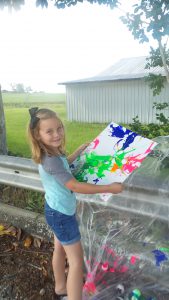 them up and about would be a perfect match. One of my all-time favorite Cloverbud crafts is the perfect activity for this time of the year, especially right before the Easter season. The project outcome will be perfect for your Cloverbuds to share with their families!
them up and about would be a perfect match. One of my all-time favorite Cloverbud crafts is the perfect activity for this time of the year, especially right before the Easter season. The project outcome will be perfect for your Cloverbuds to share with their families!
MATERIALS
For this very simple Colorful Cloverbud Craft, you will need the following materials:
- large outdoor space that is okay to get painted and messy
- medium –large paint canvas per Cloverbud
- a means to lean or stand up your canvases (a cement block behind each canvas works well)
- bright neon tempura paint colors
- 6-12 eggs per Cloverbud
- 1-2 sheets of tissue paper
- scotch tape
PREPARATION
Prior to conducting this activity with your Cloverbuds, you must do a little preparation with some of the materials. Cut a dime-size hole in each eggshell and remove the egg. Wash the eggshell with soap and water and allow the eggshell to dry. Once dry, fill the eggshell 2/3 full with a bright color of tempura paint. Cover the hole with tissue paper and lightly tape closed. Place the egg back into the egg carton. Repeat until you have 6-12 eggs for each Cloverbud, depending on the size of the canvases.
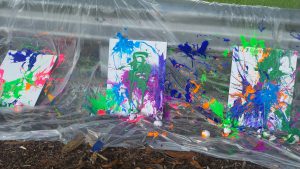 DIRECTIONS
DIRECTIONS
Instruct the Cloverbuds in advance that they are to wear old clothes and shoes for this activity. Safety glasses are recommended for this activity. Set the canvases up in a line. Have the eggs several feet back from the canvases. Instruct the Cloverbuds to toss the eggshells one at a time at their canvas, allowing the eggshell to splatter on the canvas and then drip down before picking up and tossing another one. Allow each youth to toss one egg at a time so there is no confusion and they can all watch each other’s painting being made!
CREATIVITY
This craft invites Cloverbuds to expand their creativity by choosing colors to mix and blend on their canvases. By encouraging unstructured painting, youth are allowed to explore, experiment, and create art in a non-threatening and non-judgmental environment, fostering their creativity in a group that they feel safe and comfortable in.
COORDINATION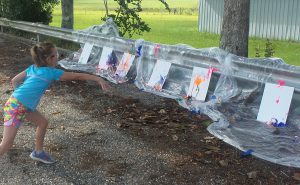
Younger youth are continuously working on physical competencies at this age and stage of development. This Cloverbud activity assists in the refinement of gross motor skills such as throwing the eggshell at the canvases. The physical action of aiming at the specific area of the canvas with the eggshell is working towards the development of fine motor skills.
COMMUNICATION
During reflection at the end of this activity, when all Cloverbuds share their final paintings with each other, youth are working towards developing increased social competence and communication skills. By having youth express how they enjoyed the activity, what they liked best, receiving positive feedback from peers and adults, and speaking before a group, they are increasing their ability to speak in front of others. By making them comfortable in a group that they feel safe, they will be more confident in themselves and their abilities at an early age.
With this bright and beautiful Cloverbud craft, the finished project makes a wonderful exhibit for each Cloverbud to present to their family for the spring holiday season. It is a great reminder for youth to show their efforts, explain to others what they learn in 4-H, and practice their communication skills.
To find out more information about other 4-H programs like this or volunteer your time to work with youth, please contact your local UF IFAS County Extension Office, or visit http://florida4h.org.
Florida 4-H Cloverbuds: A Guide for Programming for Staff and Volunteers
My 4-H Cloverbud Project Summary
Cloverbud Adventure 4-H for Kids 5-8
Volunteer Training Series: 4-H Cloverbuds Program: 4-H for Younger Members
by Julie Pigott Dillard | Oct 3, 2017
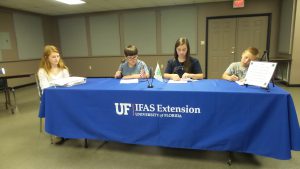
Youth should run the business portion, which should be only 1/4 of the meeting time
The very word meeting makes me sigh and roll my eyes. I’ve been to so many that are a waste of time and energy and, let’s face it, boring! Are they ever really productive? Can’t they (please) be more interesting?
Meeting is just another word for get-together, assembly, encounter, engagement, rally or reunion. When 4-H Clubs follow the club meeting model, meetings can actually be fun! The 4-H Club meeting has three distinct parts: business, recreation and educational program. Business should take up 25% of the agenda, the educational program 50% and recreation 25% of your meeting time. The order of your 4-H Club meeting isn’t set in stone; club officers and leaders can be creative in how they set up the agenda for each club meeting.
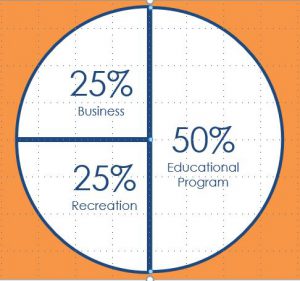 Dysfunction #1 – Adults Lead the Business Meeting
Dysfunction #1 – Adults Lead the Business Meeting
There’s no way around it; 4-H Clubs have business that needs to be dealt with including roll call, secretary and treasurer reports, committee reports, old and new business and announcements. It’s tempting for club leaders to take over and do this part of the meeting, but our youth learn nothing from this! Some of the most useful skills youth develop come from getting ready for the actual meeting and leading their peers in an organized setting, and as an adult, it’s really cool to see youth get things done efficiently. It’s also important to remember that business doesn’t have to be conducted at every 4-H Club meeting.
Dysfunction #2 – Skimping on the Educational Program
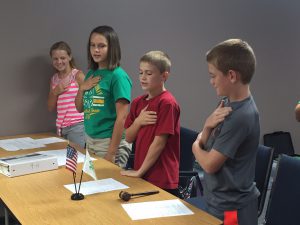
For clubs with younger youth, you can have them lead the pledges.
I’ve seen 4-H Club meetings that were literally 15 minutes long and consisted of only running through a business meeting. It made me cringe, and I know that 4-H parents were thinking the same thing as me… “Did I really leave my house for this?” “I could be sitting at my house in my PJ’s.” “I have three loads of laundry I should be folding.” “Is this all? It took me more time to drive here!” The educational program is the most important part of our 4-H Club meetings! After all, 4-H is in the business of providing high-quality educational experiences for its members, and those experiences can be pretty easy to pull together. Here are a few examples:
- 4-H Club members share what they’re doing with their projects.
- Invite a guest speaker.
- Take a short field trip.
- Show a video.
- Practice for judging contests or do a skill-a-thon.
- Create a fair project.
- Work on a community service project.
Dysfunction #3 – Forgetting the Fun
My co-worker, John Lilly, has a tag line on his email signature – Jefferson County 4-H is the place where there’s fun in learning and learning in fun! I firmly believe that the club that plays together stays together. Why? Because kids are going to want to come back, volunteers are going to stay engaged and most importantly, the parents will bring their kids back. Recreation helps kids make new friends and learn important social skills. Whether it’s through songs, ice-breakers, games, team-building activities or food, don’t forget to inject fun into 4-H meetings.
As a club member, leader or parent, you can help your 4-H Club avoid these three dysfunctions. Good 4-H Club meetings help youth make new friends, develop social skills, increase confidence and leadership and make decisions. To learn more about 4-H Club meetings, visit the florida4h.org and explore our Volunteer Training Series. The information here is great for club leaders but also for youth leaders and parents.












